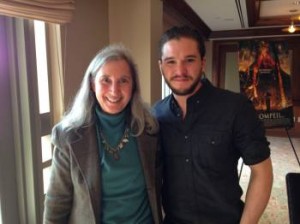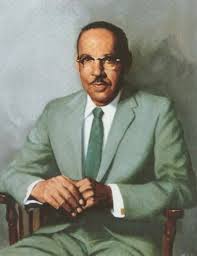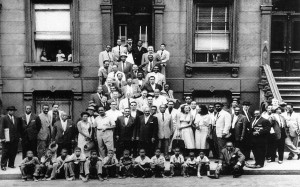Interview: Kit Harington of “Game of Thrones” and “Pompeii”
Posted on February 19, 2014 at 8:00 am
Kit Harington (Jon Snow in “Game of Thrones”) stars as Milo in this week’s 3D epic, “Pompeii.” He plays a gladiator who falls in love with Cassia (Emily Browning), the beautiful daughter of a wealthy merchant. His gladiator opponent-turned friend is played by “Thor’s” Adewale Akinnuoye-Agbaje and they have some tremendously exciting fight scenes. We talked about why fight scenes help you act, which actor is his hero, why there’s a 1980’s Disney movie he wishes he could have been in, and why actors in movies set in ancient Rome always seem to speak with British accents. We will also hear Harington’s elegant English accent in the forthcoming “How to Train Your Dragon 2.”
I want to ask you about your co-star, Adewale Akinnuoye-Agbaje, because I am a big fan and he was great in this movie.
He came to the movie quite late and he came in with such enthusiasm. He is somewhere on that method kind of level when he is on the set. He is very, very dedicated. He’s got wonderful gravitas and wonderful presence about him. I was very lucky to have him as that character because it was that character that I was most concerned about when I signed up for the movie. I was very happy to have him.
It was as much about your relationship with him as it was about your relationship with Emily Browning’s character.
Absolutely. I was lucky with both actors. It is the most nervewracking thing meeting your other castmates because you are going to be working closely with them. I was lucky with both Emily and Adewale.
I was hugely impressed with your fighting skills in this. You had so many different styles of fighting and so many different kinds of encounters and you were just on top of it all of the time. So how did you learn how to fight and were these different fighting skills or weapons than you had before?
I love it. I wouldn’t have done this movie if I did not like sword fighting but I know I am good at it. I think I am fine to say that. I really enjoy it. And it is a wonderful process learning to fight because I’d never done anything quite like this and so I had to go to gladiator school for training. It went on for four weeks and they gave me two weapons. I had to start learning the other hand on how to fight. What happens is you slowly learn these fights in stages, stage by stage and you build up and then they get so fast and so fluid that they just look like a dance where you are clocking steps and that is when you have to put the intention back in. You say to yourself, “I go for the strike here and now I see the opening there, and now I’m going to go for a thrust there.” It is a dance but it is also a dialogue. I find you can lose yourself in an acting sense in a fight far more easily than you can in a dialogue scene and I love that about it. We try as actor all the time, we strive just to completely sort of lose ourselves in the moment and we never quite get there but in a fight you can do it in seconds that is what I love about it.
What weapons were new to you and what were the challenges of learning them?
Two-handed short sword in the first place. It is almost like a dagger and it was wonderful for the character because he is so very fast and he is meant to be this blur of speed and that is his strength. Sword and shield I had never used. I had never thrown a spear before. I had to do chain work where I wrapped chains around things and stopped people. There were all sorts. Every day I came in they had something new for me to do. There were different types of swords that I would fight with. I had to throw a sword a couple of times that was fun. At one point I have to turn around and throw this sword at a guy and there was a stuntman there and I had to miss him by as small amount as I could. At one point it went right past his right arm and stuck into the wall behind. It felt very cool but it was very scary.
Your character barely speaks for the first half of the movie. It is all internal. So tell me a little bit about how you thought about his background and how that informed this character.
I do like characters like that. I thought of the kind of characters Steve McQueen played. Sometimes there were lines in this where we get rid of them because I feel in a movie like this in this sort of period of history in that social status from that background I don’t think people did wax lyrical. I don’t believe they did talk in the way we talk now or philosophize in the way that we do in the modern sense and they were not modern men as we know them. So I feel the realism comes when he only says the bare minimum of what he has to say and he is very silent. I like that. I like characters who are internal, silent, and still; so I wanted to get rid of most of his lines and I sort of did.
And are you as good with horses as Milo is? Have you been around horses a lot?
People keep putting me with horses. That is so strange. My first ever job was a job called “War Horse” where I was a horse whisperer that and then on “Thrones” I ride horses all the time and in a different movie I do ride horses. In this I’m a horse whisperer. I have a healthy respect for horses I think it is fair to say. I know how to ride very well now. Once you get into the country notion of galloping it is a beautiful thing. It feels like floating on air. I have this weird thing whenever I see someone on a horse I think it is just the oddest image because if you just take yourself out of it, it is a monkey riding a horse and I always think that is very funny. When I see people on horseback, I’m like how did we ever get them to let us do that? And what is that animal putting up with us on its back?
I want to ask you about the green screen. How much did you know about what it was going to look like and how much was green screen?
They built half a coliseum. And there is less green screen in the movie than you would actually first think. They built half a coliseum and then they did lots of reverse angles. The top half of it is green screened because they can’t build the whole thing but the streets in the street scenes, the cellars, all of that were real sets. It was pretty much some of the big wide shots and the volcano exploding they used the CGI for and it is tricky to act with. But the ash was actual ash. So we spent weeks and weeks breathing this stuff in. All of the camera crew and the directors and everyone had masks on. And I was going, “Are you sure this stuff is safe to breathe in?” And they would go, “Yeah, no, it is fine, don’t worry about it.” Like just get on with it. So I’m sure there’s a lawsuit in the making.
Where was it?
In Toronto. We filmed it all in this one big massive studio in Toronto. I love location work. I love going out but there is something quite theatrical about always being in the same place and we came back to work at the same studio each day and it felt like going on to a theater stage every night. It was a bit like that.
Why do you think it is we keep coming back to these sword and sandals stories? Why is it that those stories are so incredibly important in our culture?
I think it is the same reason why Pompeii is one of the greatest and most visited archeological sites in the world. We are fascinated with our own history and we are fascinated with the Romans because they were millennia ago and yet they still capture our imagination because they were actually so similar to us. They were very civilized. They had a very similar political system. I think that is why we are fascinated by it because we want to as humans we want to imagine ourselves in a different time period, a different culture, and in a different civilization. I think people love movies like this because we hear the story about Pompeii and we want to see it. We want to imagine it. We want to see it. We want it brought to life. It is as simple as that really. And also you can go back to that time and I don’t think our lust for blood sport has changed. I think our morality has about it but I don’t think our lust has, or our human desire to see fighting. It is still very there. It was very interesting, I went to an ice hockey game when I was in Toronto. And they dropped their gloves and started fighting and the whole crowd was like, “Come on!” and they were cheering and I looked around and I went, “This is perfect. This is exactly what the Romans were into. It was seeing two men go at it.”
Were you injured at all when you were making the film?
Oh yeah…never seriously injured but I picked up a lot of knocks. This finger here will never be the same. It is slightly swollen as you can see and it will always be now. It is like a minor thing but it does get on your nerves.
Why is it that we always have people in ancient Rome speaking with English accents?
For some reason it doesn’t work in American. It is really strange. It would not work in Australian either. We see Australia and the US as the new world and we know it as the new world and we see the UK and Europe as the old world so you can have Spanish accents, you can have English, Scottish. I mean it is not just an English accent, it is a British accent¸ you can have a Scottish accent, you can have a French accent. It works for the whole of Europe. Medieval you know.
When you were growing up what were the movies where you said, “This is what I want to do?”
“Romeo and Juliet,” that was a big marker for me and seeing DiCaprio do that was fantastic. There is a brilliant movie called “25th Hour.” It was written by David Benioff who wrote “Thrones.” When I get drunk I always start quoting that speech. It was plays more than anything really and I saw two plays that were big markers in my career. When I was about 14 I saw “Waiting for Godot” and I absolutely adored it. I thought it was the best thing since sliced bread and it made me pick up drama. The other one was “Hamlet” that I saw when I was 17 which made me want to go to drama school and that was Ben Wishaw playing Hamlet and he was just mesmerizing. He is the only person that has ever made me tongue-tied when I met him. I didn’t know what to say and went very red around the face and sort of had to walk off. He is a hero of mine.
And if you could be in any movie from the past, what movie would you pick?
I would be on “Honey I Shrunk The Kids.” I always thought that was fun. Slide down things and stuff.





